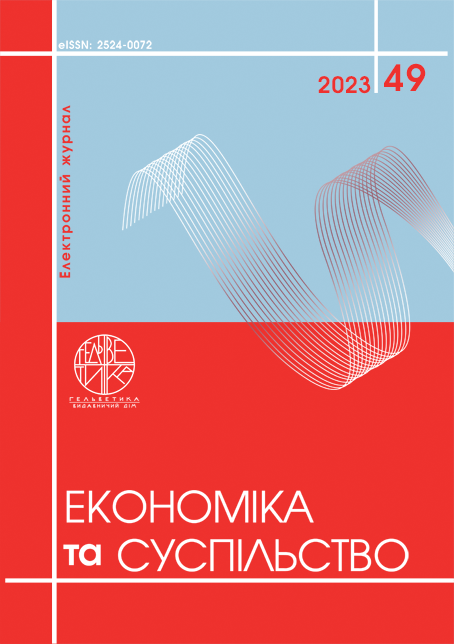ASSESSMENT OF THE RISK OF FRAUD IN THE COMPANY
Abstract
The article proposes a methodology for assessing the overall risk of fraud at a company and its potential impact on the company's activities. Risk assessment is a necessary condition for the development of effective strategies to minimize the consequences of fraud and ensure the financial security of the company. Additionally, the article highlights the relationship between the number of additional and modified audit procedures necessary to detect fraudulent activities at the company and the level of fraud risk and the strength and scale of its impact (in the event of its occurrence) on the company's activities. The study systematizes additional and modified audit procedures that should be applied if a significant level of fraud risk is detected at the company, generally or by specific subjects or their groups. These procedures are systematized in terms of management personnel and those with higher powers, other employees of the company, institutional peculiarities of the company and its activities, contractors, etc. Additionally, it has been established that there is a direct correlation between the strength of the potential negative impact of fraudulent activities on the company's activities and the number of additional and modified audit procedures required to detect such activities. Thus, the greater the threat of fraud at the company, the more procedures should be performed to prevent negative consequences. In addition, the article proposes a methodology for assessing the risk of a specific type of fraud occurring in a business, taking into account the threats of fraudulent actions at the levels of management personnel and those with the highest authority, employees of different departments of the enterprise, counterparties, as well as considering the institutional peculiarities of the enterprise and the state of its activities, the macro and global environment. This methodology for assessing the risk of a specific type of fraud in the enterprise is an important tool for improving the effectiveness of auditing. The use of such a methodology also allows businesses to analyze potential fraud threats and take effective measures to prevent them.
References
Каменська Т. Шахрайства при аудиторській перевірці. Бухгалтерський облік і аудит. 2015. № 6. С. 2–7.
Хамига Ю. Я. Фінансове шахрайство: критерії ідентифікації та напрями мінімізації. Дисертація на здобуття наукового ступеня доктора філософії за спеціальністю 072 «Фінанси, банківська справа та страхування», 2020. 308 с.
Кізима Т., Хамига Ю. Фінансове шахрайство: теоретична концептуалізація та економічне підґрунтя. Світ фінансів. 2019. Вип. 2 (59). С. 109-123.
Бура О. В., Добровольська І. І. Фінансове шахрайство в Україні та заходи протидії. URL: http://libfor.com/index.php?newsid=2879 (дата звернення: 12.10.2022).
Возняк Г. В. Фінансове шахрайство в бюджетній сфері: економічна сутність і різновиди. Бізнес Інформ. 2020. № 4 (507).
Шевцов В. М. Корпоративне шахрайство в українських компаніях. Довідник економіста. 2019. Вип. 6. С. 64-68. URL: https://sk.ua/wp-content/uploads/2019/06/%D0%A8%D0%B5%D0%B2%D1%86%D0%BE%D0%B2.pdf (дата звернення: 13.10.2022).
Кудирко О. М. Внутрішній аудит в Україні: сутність проблеми розвитку та шляхи їх усунення. Вісник Хмельницького національного університету. 2011. № 5, T. 1. С. 186-189. URL: http://journals.khnu.km.ua/vestnik/pdf/ekon/2011_5_1/186-189.pdf (дата звернення: 15.02.2023).
Климко Т. Ю., Мельник О. О. Корпоративне шахрайство: реалії сучасності. Науковий вісник Ужгородського університету. Серія: Економіка. 2015. Вип. 2. С. 185-190. URL: http://nbuv.gov.ua/UJRN/Nvuuec_2015_2_33 (дата звернення: 22.01.2023).
Стецюк О. Я., Чубай В. М. Виявлення шахрайства на підприємстві: алгоритм дій та ознаки, які вказують на значний ризик наявності шахрайських дій. Економіка та суспільство. 2023. №48. URL: https://economyandsociety.in.ua/index.php/journal/issue/view/48
Стецюк О. Я., Чубай В. М. Шахрайство на підприємствах: види, критерії ідентифікації та причини виникнення. Економіка та суспільство. 2023. №47. URL: https://economyandsociety.in.ua/index.php/journal/issue/view/47
Міжнародний стандарт аудиту 240 «Відповідальність аудитора, що стосується шахрайства, при аудиті фінансової звітності». URL: https://www.apu.net.ua/attachments/article/1151/2017_часть1.pdf (дата звернення: 11.10.2022).
Kamenska T. (2015). Shakhraistva pry audytorskii perevirtsi. [Audit fraud]. Bukhhalterskyi oblik i audyt (6nd ed., pp. 2–7) [in Ukrainian].
Khamyha Yu. Ya. (2020). Finansove shakhraistvo: kryterii identyfikatsii ta napriamy minimizatsii. [Financial fraud: identification criteria and directions for minimization]. Dysertatsiia na zdobuttia naukovoho stupenia doktora filosofii za spetsialnistiu 072 «Finansy, bankivska sprava ta strakhuvannia» (308 p) [in Ukrainian].
Kizyma T., Khamyha Yu. (2019). Finansove shakhraistvo: teoretychna kontseptualizatsiia ta ekonomichne pidgruntia. [Financial fraud: theoretical conceptualization and economic background]. Svit finansiv ‒ The world of finance (2nd ed., pp. 109–123) [in Ukrainian].
Bura O. V., Dobrovolska I. I. Finansove shakhraistvo v Ukraini ta zakhody protydii. [Financial fraud in Ukraine and countermeasures]. Retrieved from http://libfor.com/index.php?newsid=2879 [in Ukrainian].
Vozniak H.V. (2020). Finansove shakhraistvo v biudzhetnii sferi: ekonomichna sutnist i riznovydy. [Financial fraud in the budget sphere: economic essence and varieties]. Biznes Inform (4nd ed., 507 p.) [in Ukrainian].
Shevtsov, V. M. (2019). Korporatyvne shakhraistvo v ukrainskykh kompaniiakh. [Corporate fraud in Ukrainian companies]. Dovidnyk ekonomista ‒ Handbook of the economist (6nd ed., pp. 64-68). Retrieved from https://sk.ua/wp-content/uploads/2019/06/%D0%A8%D0%B5%D0%B2%D1%86%D0%BE%D0%B2.pdf [in Ukrainian].
Kudyrko O. M. (2011). Vnutrishnii audyt v Ukraini: sutnist problemy rozvytku ta shliakhy yikh usunennia. [Internal audit in Ukraine: the essence of the development problem and ways to eliminate them]. Visnyk Khmelnytskoho natsionalnoho universytetu ‒ Bulletin of the Khmelnytskyi National University (5nd ed., pp. 186–189). Retrieved from http://journals.khnu.km.ua/vestnik/pdf/ekon/2011_5_1/186-189.pdf [in Ukrainian].
Klymko T. Yu., Melnyk O. O. (2015). Korporatyvne shakhraistvo: realii suchasnosti. [Corporate fraud: modern realities]. Naukovyi visnyk Uzhhorodskoho universytetu ‒ Scientific Bulletin of Uzhhorod University Seriia: Ekonomika (2nd ed., pp. 185-190). Retrieved from http://nbuv.gov.ua/UJRN/Nvuuec_2015_2_33 [in Ukrainian].
Stetsiuk O. Ya., Chubai V. M. (2023). Vyiavlennia shakhraistva na pidpryiemstvi: alhorytm dii ta oznaky, yaki vkazuiut na znachnyi ryzyk naiavnosti shakhraiskykh dii. [Detection of fraud in the enterprise: an algorithm of actions and signs that indicate a significant risk of fraudulent actions] (48nd ed.). Retrieved from https://economyandsociety.in.ua/index.php/journal/issue/view/48 [in Ukrainian].
Stetsiuk O. Ya., Chubai V. M. (2023). Shakhraistvo na pidpryiemstvakh: vydy, kryterii identyfikatsii ta prychyny vynyknennia. [Fraud at enterprises: types, identification criteria and causes of occurrence] (47nd ed.). Retrieved from https://economyandsociety.in.ua/index.php/journal/issue/view/47 [in Ukrainian].
Mizhnarodnyi standart audytu 240 «Vidpovidalnist audytora, shcho stosuietsia shakhraistva, pry audyti finansovoi zvitnosti». [Auditor's responsibility for fraud in the audit of financial statements]. Retrieved from https://www.apu.net.ua/attachments/article/1151/2017_chast1.pdf [in Ukrainian].


